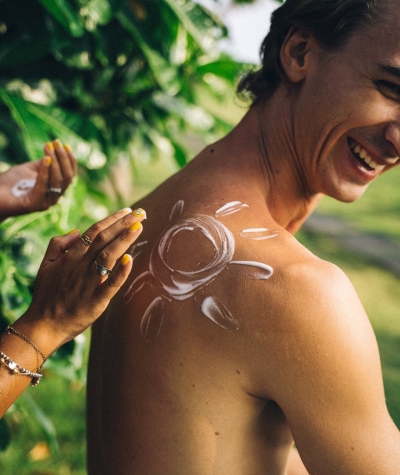In this page you can find information on:
- Water-resistant sunscreen
- Durable sunscreens
- Creamy and clear formulations
- Moisturisers and foundations with SPF
There is a wide range of products which include additional benefits, such as water-resistant or longer-lasting protection.Whatever sunscreen type we choose, we can be confident in using it because sunscreens are developed by scientists with expert suncare knowledge and are covered by strict safety laws.
Water-resistant sunscreen
Water-resistant sunscreens have been formulated to resist being washed off by water, for example during swimming, and have been thoroughly tested to make sure they work as labelled. These products may be labelled as water resistant or very water resistant. However, no product is 100% resistant to being washed off with water, therefore no sunscreen can be completely 'water-proof'. The laws that cover the manufacture of cosmetic products require that all claims made must be substantiated.
The aim of the validated test method used by suncare manufacturers is to determine that the sunscreen will not be completely washed off while being worn in the water. Interestingly, tap water is used in the test as it is a more harsh solvent than salt or chlorinated water. To pass the test, a product must retain at least 50% of the initial SPF value after immersion in water. In fact an SPF 30 product will stop approximately 97% of UV rays reaching the skin and after robust water resistance testing the product will still filter out at least 93% of the sun's UV rays. However a non-water-resistant product could be washed off the skin completely meaning no protection from UV rays (until reapplication). The 'dry' SPF number is a far more realistic indicator of the product's protection for all round use, while still offering protection after time in the water.
Of course we should always follow the instructions and re-apply our sunscreens regularly and especially after we have been swimming or towelling dry, even water-resistant products.
Durable sunscreens
Dr Emma Meredith, Director-General of CTPA, explains how durable sunscreens are intended to be used.
Products which offer durable protection are formulated to stay on the skin longer while maintaining their sun protection. They are useful for people who can't avoid extended sun exposure or who are not able to reapply as is normally recommended, for example walkers, people participating in outdoor sports and outdoor workers.
There are various ways in which these products are designed:
-
some products incorporate ingredients that help the UV filters penetrate the upper layers of the skin where they are protected more from being rubbed-off
-
some use active ingredients which adhere to the skin
-
others rely on the technique of binding the UV filter tightly to the skin, using water and abrasion-resistant material.
Whatever the technology, the end result is a product that will stay on the skin longer while maintaining its level of sun protection. Manufacturers of durable sunscreens will comply with the same safety and claim substantiation requirements as for traditional sunscreens and will have carried out robust testing to ensure the product will provide the expected level of protection.
As with all sunscreens, it is important to follow the instructions for application and use; and remember not to use sunscreen to stay longer in the sun.
Creamy and clear formulations
Most sun creams are opaque, i.e. they look creamy. That is because they are emulsions. Emulsions are made by mixing oil-loving and water-loving ingredients together (which under normal circumstances would not mix together), and stabilising the mixture through the use of special materials called emulsifiers. UV filters are either water-soluble or oil-soluble and an emulsion will usually contain a combination of these filters. A transparent product can be achieved if the formulation does not include emulsification, because the ingredients are either only oil-loving or only water-loving ingredients.
It is now also possible to formulate a transparent or clear sunscreen that is not only non-oily but also offers medium to very high protection.
If you want to find out about different types of ingredients in your products, visit the A-Z of terms and ingredients.
Moisturisers and foundations with SPF
Certain types of moisturisers and foundations contain added protection from UV rays to help combat the rays' anti-ageing effects, because it's well-known that being out and about in strong daylight - even when it's not that sunny - can contribute to the ageing process. Such products are not intended to be used as primary sun protection: their main function is as a moisturiser or foundation and should be used in the same way you would use any other product of that type. If you're wearing these products and you're going to spend time in the sun, you still need to apply sunscreen.
Remember to layer your sunscreen and makeup rather than mixing the products together. Applying your sunscreen and makeup in separate layers will help ensure you achieve the expected level of protection from your sunscreen. Remember to follow the instructions on the sunscreen bottle about how to apply it.


